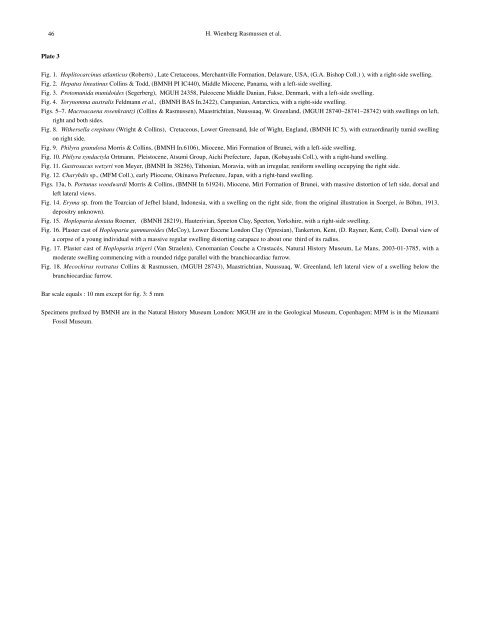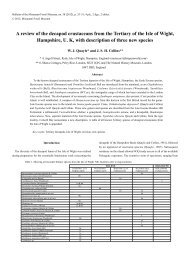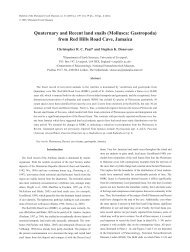Raninidae infested by parasitic Isopoda (Epicaridea)
Raninidae infested by parasitic Isopoda (Epicaridea)
Raninidae infested by parasitic Isopoda (Epicaridea)
Create successful ePaper yourself
Turn your PDF publications into a flip-book with our unique Google optimized e-Paper software.
46<br />
Plate 3<br />
H. Wienberg Rasmussen et al.<br />
Fig. 1. Hoplitocarcinus atlanticus (Roberts) , Late Cretaceous, Merchantville Formation, Delaware, USA, (G.A. Bishop Coll.) ), with a right-side swelling.<br />
Fig. 2. Hepatus lineatinus Collins & Todd, (BMNH PI IC440), Middle Miocene, Panama, with a left-side swelling.<br />
Fig. 3. Protomunida munidoides (Segerberg), MGUH 24358, Paleocene Middle Danian, Fakse, Denmark, with a left-side swelling.<br />
Fig. 4. Torynomma australis Feldmann et al., (BMNH BAS In.2422), Campanian, Antarctica, with a right-side swelling.<br />
Figs. 5–7. Macroacaena rosenkrantzi (Collins & Rasmussen), Maastrichtian, Nuussuaq, W. Greenland, (MGUH 28740–28741–28742) with swellings on left,<br />
right and both sides.<br />
Fig. 8. Withersella crepitans (Wright & Collins), Cretaceous, Lower Greensand, Isle of Wight, England, (BMNH IC 5), with extraordinarily tumid swelling<br />
on right side.<br />
Fig. 9. Philyra granulosa Morris & Collins, (BMNH In.6106), Miocene, Miri Formation of Brunei, with a left-side swelling.<br />
Fig. 10. Philyra syndactyla Ortmann, Pleistocene, Atsumi Group, Aichi Prefecture, Japan, (Kobayashi Coll.), with a right-hand swelling.<br />
Fig. 11. Gastrosacus wetzeri von Meyer, (BMNH In 38256), Tithonian, Moravia, with an irregular, reniform swelling occupying the right side.<br />
Fig. 12. Charybdis sp., (MFM Coll.), early Pliocene, Okinawa Prefecture, Japan, with a right-hand swelling.<br />
Figs. 13a, b. Portunus woodwardi Morris & Collins, (BMNH In 61924), Miocene, Miri Formation of Brunei, with massive distortion of left side, dorsal and<br />
left lateral views.<br />
Fig. 14. Eryma sp. from the Toarcian of Jefbel Island, Indonesia, with a swelling on the right side, from the original illustration in Soergel, in Böhm, 1913,<br />
depositry unknown).<br />
Fig. 15. Hoploparia dentata Roemer, (BMNH 28219), Hauterivian, Speeton Clay, Speeton, Yorkshire, with a right-side swelling.<br />
Fig. 16. Plaster cast of Hoploparia gammaroides (McCoy), Lower Eocene London Clay (Ypresian), Tankerton, Kent, (D. Rayner, Kent, Coll). Dorsal view of<br />
a corpse of a young individual with a massive regular swelling distorting carapace to about one third of its radius.<br />
Fig. 17. Plaster cast of Hoploparia trigeri (Van Straelen), Cenomanian Couche a Crustacés, Natural History Museum, Le Mans, 2003-01-3785, with a<br />
moderate swelling commencing with a rounded ridge parallel with the branchiocardiac furrow.<br />
Fig. 18. Mecochirus rostratus Collins & Rasmussen, (MGUH 28743), Maastrichtian, Nuussuaq, W. Greenland, left lateral view of a swelling below the<br />
branchiocardiac furrow.<br />
Bar scale equals : 10 mm except for fig. 3: 5 mm<br />
Specimens prefixed <strong>by</strong> BMNH are in the Natural History Museum London: MGUH are in the Geological Museum, Copenhagen; MFM is in the Mizunami<br />
Fossil Museum.





